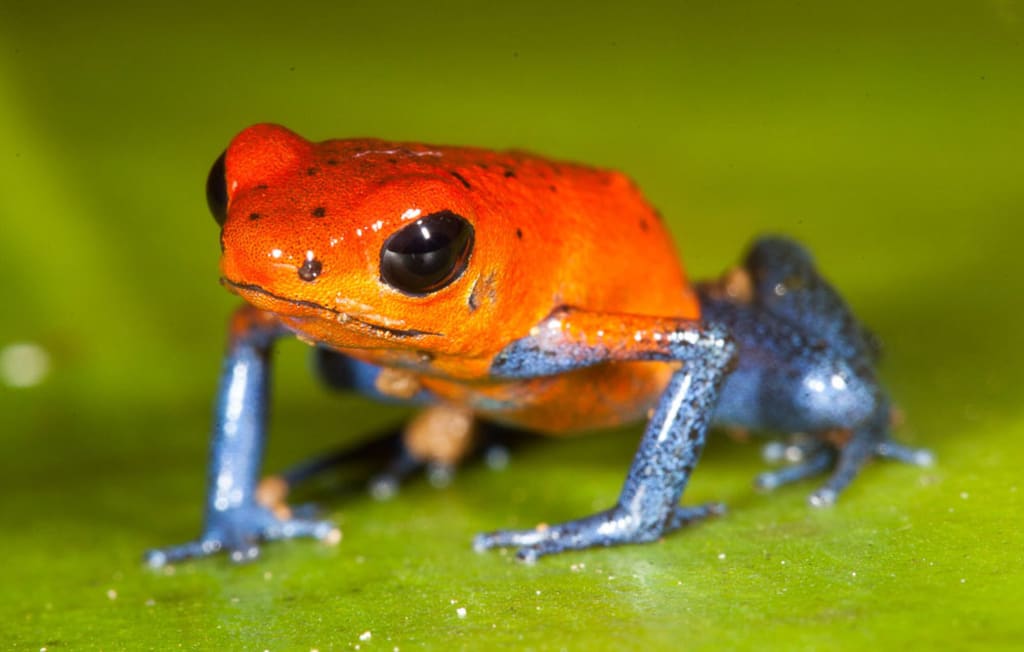Colorful But Poisonous Frogs
The dangerous dart frogs of Central and South America

Frogs with a Reddish Hue
Of the genus, Oophaga, the most toxic frogs are the strawberry poison dart frogs. These frogs make their home in Central America. They change hues and can be totally red to a denim kind of color or even green with black spots. is changing and can be completely red to a “denim” kind of color or all the way to green with black spots.

Native to the Amazon rainforests of Ecuador and Peru, the red-backed poison dart frogs are similar in coloring to the splash-back. These frogs can kill smaller predators like birds and can cause serious injury to humans. The frogs get their toxicity from the neurotoxic venom that is, in the ants they eat.

Making their home in Panama and Costa Rica, granular poison dart frogs have bright red bodies warning of their toxicity. Unfortunately, they are endangered because of their habitat loss. Among their biggest predators are humans who capture them to sell as pets.

Bright yellow frogs
Native to Columbia, the yellow-striped poison dart frogs look as bright as the sun. These are the least toxic of their genus. However, they're deadly enough to cause predators heart failure with their toxin when they are eaten.

Making their home in Columbia, Brazil, and Guyana, the yellow-banded poison dart frogs are also known as the bumblebee poison frogs. With their poison, they can kill their predators.

Found in Ecuador and Columbia, splash-back poison dart frogs have poison that secretes from their skin and can kill up to five humans. The color of their backs ranges from lemon yellow to orange to red.

In the rainforests of Columbia, black-legged dart frogs are the second most toxic ones. They have orange or yellow bodies with dark blue or black hindlegs and forelimbs.

Living on some isolated rainforest islands in the Sipaliwini savannah of southern Suriname blue poison dart frogs have a bright blue hue with black spots. When these frogs are in captivity they lose their toxicity and because of this have become popular to capture and sell as pets.

Making their home in various South American countries, particularly Venezuela, dyeing dart frogs are among the largest species of poison dart frogs. Not only are they bigger, but they are also hardier than other poison frogs. Their poison is used by the indigenous tribes of the Guiana Shield for arrow tips when hunting. These tribes also rub the skin of young parrots with the poison so their feathers grow in different colors.

Native to Ecuador, phantasmal poison dart frogs are tiny but have enough poison in them to kill adult humans. The poison from these frogs has been used in studies developing a painkiller called epibatidine, which is 200 times more powerful than morphine and with no addictive qualities. Unfortunately, these tiny frogs have become endangered.

Living in the tropics of Central and South America, kokoe poison dart frogs are very toxic when in the wild. They make unusual bird-like calls. Male frogs use the calls loudly against other male frogs until one of them backs down and the other remains the dominant one. If the poison of these frogs gets into wounds, it causes pain, fever, and seizures.

Making their home in the rainforests of Costa Rica, golfodulcean poison dart frogs secrete a poison that causes excruciating pain, and mild seizures, and can result in paralysis. Due to habitat loss, these frogs are endangered.

Living in Central and South America, green and black poison dart frogs have enough poison in them to make humans very ill. They are lovely-looking frogs with hues that range from green to mint to lime to emerald and turquoise. They have become popular to sell as pets.

Native to Columbia and Ecuador Harlequin poison dart frogs have so much toxin within them that indigenous people use the poison for deadly darts.
About the Creator
Rasma Raisters
My passions are writing and creating poetry. I write for several sites online and have four themed blogs on Wordpress. Please follow me on Twitter.






Comments
There are no comments for this story
Be the first to respond and start the conversation.